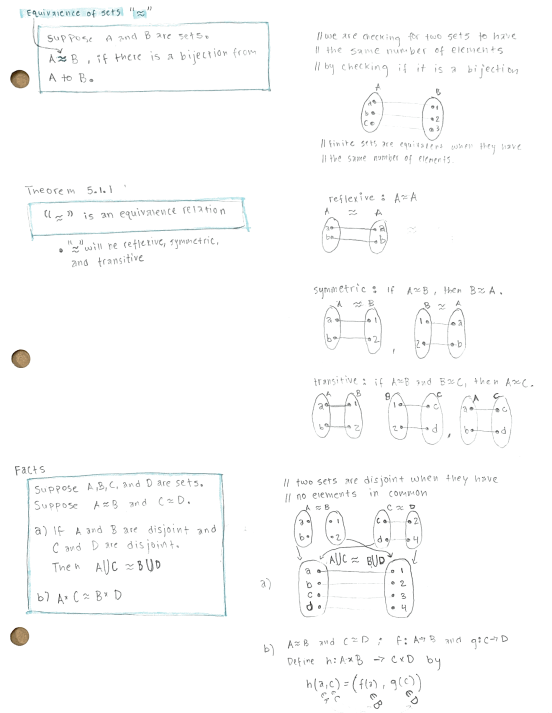How am I learning?
The provided example is a page of my final draft of my lecture notes. The information on the left side is the important theorems and ideas that were provided during the lecture. When reviewing my lecture notes, I compared my notes to the textbook to see if I was provided enough relevant information for the theorem to make sense. With my understanding of the theorems satisfied, I would write the theorems on the left side in the manner which either my professor or the textbook explains it. However, to transfer the knowledge to myself and make it uniquely my own, I write my own interpretation of the theorems on the right-hand side of my notes. I actively look for ways to incorporate visuals to capture definitions, and I also try to rewrite prior theorems and definitions that are used to arrive at the new theorem. For example, equivalence relations are covered in chapter three but we are in chapter 5, however, I recall the definition of requiring the properties of being reflexive, symmetric, and transitive, and then draw visuals to show my understanding of those properties.

What am I Learning?
In this lecture, I was covering what makes sets equal to one another. Two sets are equivalent if they are said to be in terms of one-to-one correspondence (a bijection) from one set to another. What does that mean in my own words? If I have two sets A and B, then each value in the range of B must be mapped to at most one unique value in the domain of A, also all the possible outputs of B must have exactly one corresponding input from A. The properties of being equivalent sets (having an equivalence relation) are being reflexive (a = a), symmetric (if a = b, then b = a), and transitive (if a = b and b = c, then a = c).
Why am I learning?
As I went through this learning process. I’m not sure why I was learning this material, it was just part of the curriculum. So I have begun to look even broader than that, why is this part of the curriculum? If I had to choose one overlapping theme where all these individual components come together, I would pinpoint it to Set Theory.
So what is the relevance of set theory? Why are we interpreting it into the curriculum? What role does set theory play in mathematics? From what I have been able to scrap from the bottomless abyss of the internet, I have seen set theory being important for allowing us to treat a collection of mathematical objects as a mathematical object on its own right. With sets allowing us to have a collection of related objects, we can thus build more complex mathematical structures. Set theory allows for these complex structures because it also provides the axioms from which the rest of mathematics is built upon. Axioms are statements that are taken to be true, to serve as a starting point for further reasoning and arguments.
With all this in mind, I have a better understanding of how these individual components play a role in set theory that plays a role in building up arguments and proofs for my abstract math class. This conceptual approach of building ideas up from a foundational understanding is definitely a new experience compared to my experience in a more formulaic approach to math which I have practiced throughout high school and my early calculus experiences.
Related Topics and Definitions
Set Theory: Starting from the theory of sets, once can construct all the number systems, functions, calculus, and other areas of mathematics. Thus, the study of sets is the foundation for the entire structure of mathematics.
Equivalence of Sets: To determine whether two sets have the same number of elements, we see whether it is possible to match the elements in a one-to-one fashion. This idea may be described as one-to-one correspondence from one set to another.
One-to-one correspondence: Bijection aka both 1-1 and onto
Cardinality: The number of elements in a set or other grouping, as a property of that grouping
Finite Sets: A set with a finite number of elements
Equivalence Relations: Describing a way to equate objects in a set according to some value, property, or meaning. In our case, reflexive, symmetric, transitive.
Relations: How objects in a set are related
Onto: the codomain is the range, as all possible outputs of y have a corresponding x
One-to-one: Each value in the range can be mapped to at most one unique value in the domain
Bijection: Both onto and 1-1
